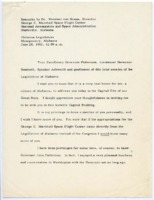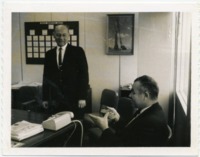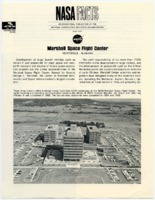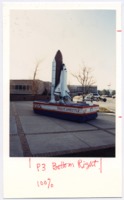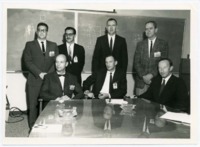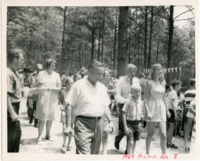
Browse Items (96 total)
Sort by:
-
Abbreviated timeline of the Apollo 11 mission.
The timeline includes a memorandum from Friedjof A. Speer, manager of the Missions Operations Office, to employees of Marshall Space Flight Center. Speer notes that "astronaut Neil Armstrong is scheduled to be the first man to step onto the moon's surface." The timeline outlines the entire mission from liftoff at 8:32 AM on Wednesday, July 16, 1969 to splashdown at 11:49 AM on Thursday, July 24, 1969. -
Transcript of a speech given by Wernher von Braun to the Alabama Legislature.
Von Braun, then the director of Marshall Space Flight Center in Huntsville, Alabama, delivered this speech to the legislature in 1961. In the speech, he emphasizes that Alabama must take advantage of its position in the aerospace industry and create a robust "academic and research environment" in Huntsville to attract businesses that "will give birth to major new industries throughout the state." He exhorts the legislature to fund the newly established University of Alabama Research Institute (now part of the University of Alabama in Huntsville), arguing that "the Institute will not only be self-sustaining, but will enrich the State both financially and culturally." The legislature later approved von Braun's request of $3 million for the Research Institute, enabling the purchase of 200 acres of land for the campus and the construction of the Institute in 1964. The speech includes copies of slides von Braun used during his presentation, including diagrams of Saturn and Nova rockets as well as a mockup of a Saturn rocket on the lawn of the state capitol in Montgomery. -
"SkyLab: An Oral History of America's First Space Station."
This video was released in conjunction with Skylab's 30th anniversary in 2003. It contains video footage from the Skylab program as well as interviews with those associated with the program.Tags Oral History -
Transplanted Rocket Pioneers.
The information in this dataset is reproduced from Charles Lundquist's 2014 monograph Transplanted Rocket Pioneers. The information includes biographical and professional information that he compiled to produce the book. Each individual represented in the dataset also has a vertical file in the Lundquist Collection at UAH.
Transplanted Rocket Pioneers is a recognition of the early members of the von Braun rocket team, many of whom were key players in the successful moon landing. Many historians conclude that the lunar missions of the Apollo Program could not have been possible without the leadership and experience provided by a corps of engineers, scientists and managers transplanted from Europe to the Unites States after World War II. This fact motivated Dr. Lundquist to deposit this work in the Archives of the Library at the University of Alabama in Huntsville by assembling a file on each of the individuals who came from Europe to participate in the rocketry activities in Huntsville, or, in a few cases, individuals who had other ties to Huntsville.
This dataset includes a standard one-page summary sheet for each subject. Although most sheets are relatively complete, some data are still missing.
The first two lines on each page records fundamental identification information:
Family name Date of birth Place of birth Given names Date of death Place of death
The next standard entry is a statement of the extent of the Archives Holdings, either i) A primary collection of documents housed in one or more banker boxes, usually a separate individual collection ii) A secondary collection in a standard archive box, or iii) a file folder. Next, if there is an oral or video history for the individual, this fact is noted. A statement about the highest education levels of the individual follows. The next five entries, in chronological order, record whether the individual participated in activities at five sites:
1. Raketenflugplatz-Kummersdorf: Individuals engaged in the activities at these sites of early rocket development experiments sponsored first by VfR and subsequently by the German Army.
2. Peenemünde: Included here are individuals who participated in Peenemünde programs under several auspices, including as Army civilian employees, as members of the German military, as contractor employees on site or visiting as needed, and as university employees collaborating as required.
3. Fort Bliss: Individuals who were brought to Fort Bliss from 1945 to 1950.
4. GMDD-ABMA: Individuals who came to Huntsville, Alabama to work for the US Army rocket programs in the decade 1950 to 1960.
5th MSFC: Individuals who were employed by the NASA Marshall Space Flight Center in the 1960s.
Some people had various relationships with UAH and that is so noted. Additionally, a statement of immigration details is noted if pertinent. Finally, a great variety of incidental information is included under Incidental Remarks.
UAH Special Collections welcomes additions of biographical materials to the vertical file in the Charles Lundquist Collection. Please note that the work is that of Dr. Lundquist and may contain errors or omissions which are solely the product of his work on the project, as noted in the introduction of the work.: " Finally, it is pertinent to note that any document containing large files will surely have some mistakes or omission. Any errors are the responsibility of the author alone." As was the wish of Dr. Lundquist, we will strive to make factual corrections to the online copy when necessary.
-
Dr. Charles Lundquist (Space History Interviews)
Interview by David Christensen on February 10, 2005Tags Oral History -
William A. Schulze and Hans Palaoro at Marshall Space Flight Center.
The bulletin board behind Schulze reads "Vehicle Engineering Branch." Palaoro was the head of the Vehicle Systems Engineering Branch of the Structures and Mechanics Division at Marshall Space Flight Center. -
NASA Facts leaflet on Marshall Space Flight Center.
The leaflet describes Marshall's role in developing launch vehicles for the space program, its collaboration with NASA facilities in Mississippi and Louisiana, and its research and development operations. Includes a map. -
Space Shuttle Atlantis float on campus at UAH.
The float was made by Marshall Space Flight Center. Von Braun Research Hall can be seen in the background. The photo likely dates from the 1980s or early 1990s, when the NASA worm logo was still in use, as seen on the sides of the float. -
The Apollo Lunar Surface Drill team at Marshall Space Flight Center.
John Bensko, Jr. is seated in the center of the front row. -
Wernher von Braun with daughter Margrit and son Peter in the crowd at the 1969 MSFC employee picnic.
MSFC Director of Administration and Technical Services David H. Newby is shown in the foreground.

